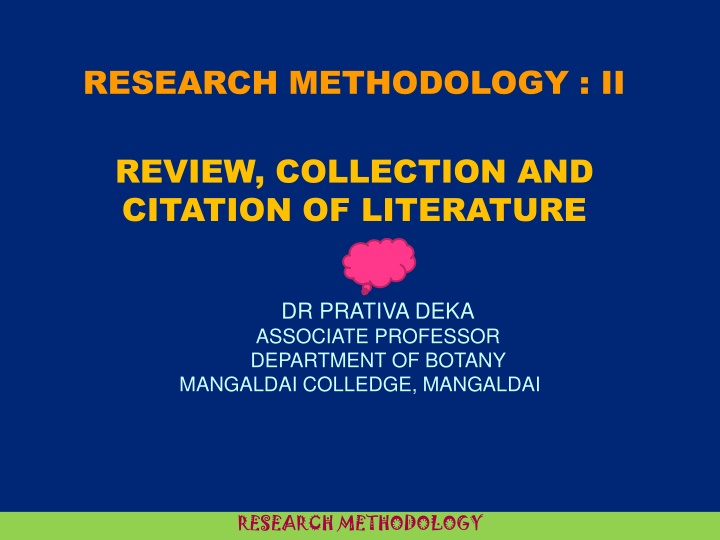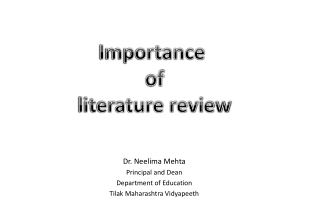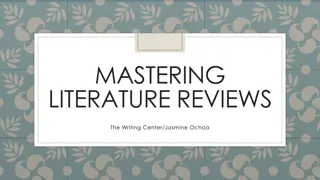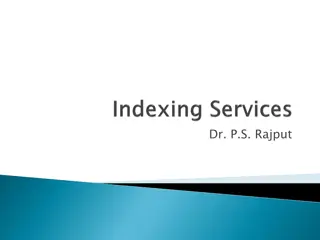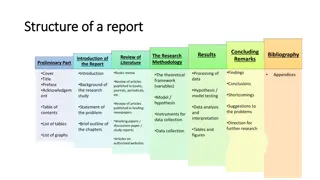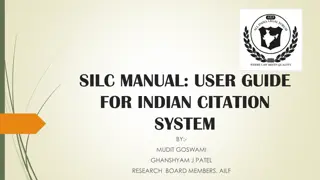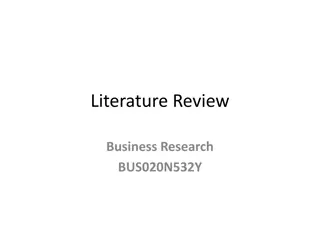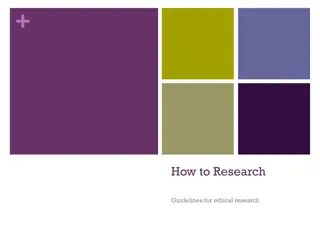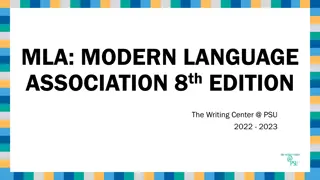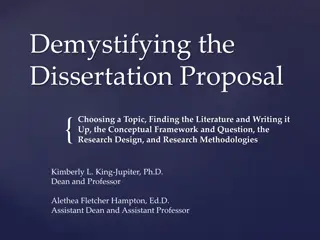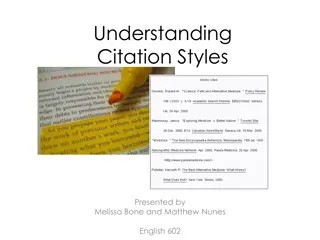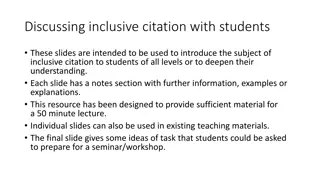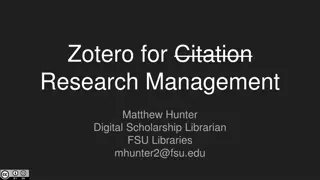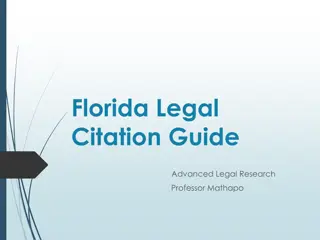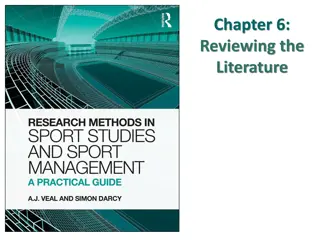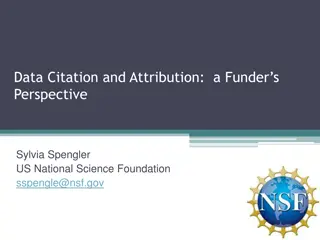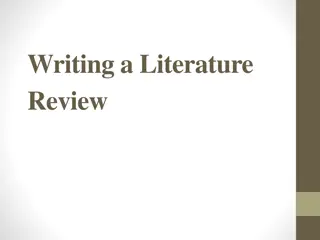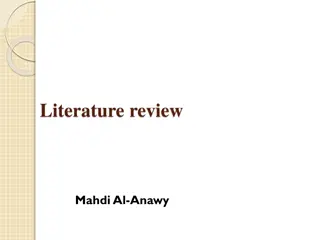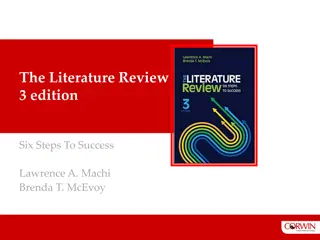Review, Collection, and Citation of Literature in Research Methodology
The review of literature in research methodology is crucial as it helps researchers acquire up-to-date information, build upon existing knowledge, and avoid redundant work. It involves examining scholarly journals, books, databases, and other sources to enhance understanding, formulate ideas, and explore research possibilities.
Download Presentation

Please find below an Image/Link to download the presentation.
The content on the website is provided AS IS for your information and personal use only. It may not be sold, licensed, or shared on other websites without obtaining consent from the author.If you encounter any issues during the download, it is possible that the publisher has removed the file from their server.
You are allowed to download the files provided on this website for personal or commercial use, subject to the condition that they are used lawfully. All files are the property of their respective owners.
The content on the website is provided AS IS for your information and personal use only. It may not be sold, licensed, or shared on other websites without obtaining consent from the author.
E N D
Presentation Transcript
RESEARCH METHODOLOGY : II REVIEW, COLLECTION AND CITATION OF LITERATURE DR PRATIVA DEKA ASSOCIATE PROFESSOR DEPARTMENT OF BOTANY MANGALDAI COLLEDGE, MANGALDAI RESEARCH METHODOLOGY
Review, Collection and citation of Literature The review is a careful examination of a body of literature pointing towards the answer to the research problem. Need for reviewing literature: Researcher needs to acquire up-to-date information about what has been thought and done in particular area. He has to build upon the accumulated and recorded knowledge of the past. He draws maximum benefit from the previous investigations, utilizes the previous finding, and takes many hints from the procedures of previous researchers. He matches his conclusions with earlier conclusions and tries to add from his side to the existing store of knowledge. RESEARCH METHODOLOGY
What to review and for what purpose Literature reviewed typically includes scholarly journals, scholarly books, and authoritative databases. Sometimes it also includes newspaper, magazines, other books, films and audio-video tapes. RESEARCH METHODOLOGY
Its specific purposes are- It helps the research worker to find what is already known, what others have attempted to find. It enables him to know the means of getting to the frontier in the field of his research. Through it he will also know in details about all the related research projects in progress but not yet completed. It provides ideas, theories, explanations, hypothesis or methods of research valuable in formulating and studying the problem. It makes him alert to research possibilities that have been looked over and research approaches that have proved to be sterile. It helps in locating comparative data useful in the interpretation of results. It prevents pointless repetition of research. RESEARCH METHODOLOGY
Literature Search procedure- Literature review has two components- 1. A search through the literature. 2. The writing of the review. RESEARCH METHODOLOGY
We should always remember the following points- We should keep constantly in mind the objective of our research. We should prepare a bibliographical card for each book or article that we believe might contain materials pertinent to our investigation. Accuracy is extremely important in preparing the cards. We should start the survey by going through the most recent of the important studies. In taking notes it should be as brief as possible. We should record the evaluation of the materials and note how it relates to our research. We should copy only those quotations that are stated very skilfully or in very concise terms. We should not rely too heavily upon secondary sources. We shouldn t concentrate only on research finding and should not overlook on methods, tools etc. RESEARCH METHODOLOGY
Sources of literature- The sources of information have been classified mainly as Primary and Secondary sources. Primary Sources:- These sources provide direct description of study by the person who has actually observed or witnessed the occurrence and carried it out. Secondary Sources:- These materials includes publications written by authors who were not direct observers or participants in the events described. RESEARCH METHODOLOGY
Sources of literature- The sources of literature have also been classified as DIRECT and INDIRECT sources. The direct sources of information are available in the form of- I. Journals. II. Books, monographs, yearbooks. III. Dissertations and thesis. IV. Government publications etc. The indirect sources are available in the form of- I. Encyclopaedia II. Indexes III. Abstracts IV. Directories and bibliography V. Bibliographical references etc. RESEARCH METHODOLOGY
Planning of Review Work- Prepare an advance plan and preset a time limit. Research questions should be written down and at hand when you arrive at the computer to search databases or a library catalogue. Are you finding too much? Are you finding too little? RESEARCH METHODOLOGY
Note Taking:- Purposeful research reading demands a systematic and simultaneous note taking. For research purposes, note taking has to be orderly, systematic and scientific. Reference notes may be classified under four main categories- Quotation:- The reader reproduces the exact words of the author and copies the material accurately. Paraphrase:- The reader restates and notes the author s ideas in his own words. Summary:- The reader records the contents of the material read by him in a condensed form. Evaluation:- The reader interprets the points of view of the author, records his own impressions and reactions and indicates his agreements or disagreement with the author. RESEARCH METHODOLOGY
Criteria for good note taking The criteria for good note taking are: Have a bird s eye view of reference source before making a decision on the material for record and use. Cultivate the art of selecting the most significant material. For ease of handling use 10cm x 15cm index card. Include only one topic or item on a card. File each note-card under a definite topic. Place the subject heading at the top of the card. Give a complete bibliographic citation at the bottom of the note card. Take notes in a complete and clearly understand form. On the very first occasion copy the notes correctly and do not plan to recopy. RESEARCH METHODOLOGY
Citation of Literature: A citation is a reference that allows you to acknowledge the sources you use in a formal academic paper, and enables a reader to locate those sources information it provides. through the key Citations are placed both in the text and in an organized list at the end of the text, unless you use a footnote or endnote system, which can be self-contained without an organized list. RESEARCH METHODOLOGY
Citation of Literature: According to a conservative estimate Pteridophytic flora is represented by about 600 species in India (Bir 1987). Whereas according to Dixit (1984) and Dixit and Vohra (1984) the Pteridophytic flora in India comprises of 67 families, 191 genera and more than 1000 species. As a constituent of Indian flora of vascular plants, the fern and fern-allies form only 5 percent as far as number of species are concerned (Satija and Bir 1985). Recently Borthakur et al (2001) published Iluustrated Manual of Ferns of Assam which includes 221 species of ferns belonging to 87 genera and 47 families. This is the first work to include the ferns of the state as a whole but excluded the fern-allies. REFERENCES Bir, S.S. 1987. Pteridophytic Flora of India: Rare and endangered elements and their conservation. Indian F J. 4. 95-101. Borthakur, S.K., Deka, P. and Nath, K. K., 2001. Illustrated Manual of Ferns of Assam. Bishen Singh Mahendra Pal Singh, Dehradun-248001, India Dixit, R.D. 1984. A census of Indian Pteridophytes. BSI, Howrah. Dixit, R.D. and Vohra, J.N. 1984. A dictionary of Pteridophytes of India. BSI, Howrah. Satija, C.K. and Bir, S.S. 1985. Polypodiaceous Ferns of India. In Bir, S.S. (Ed.). Aspects of Plant Sciences III. Today & Tomorrow's Printers and Publ., New Delhi. RESEARCH METHODOLOGY
When writing a research paper literature citation is important for the two reasons- To avoid plagiarism. To assign proper authority to a statement (This adds weights to your paper). You may use any style of literature citation as long as the proper authorities are cited as in the text and full references are provided at the end of your paper. RESEARCH METHODOLOGY
Here is an example of a style that is common in the biological literature. In-Text Citation: Whenever you are directly quoting or paraphrasing, your reference is cited in the text, before the end of statement. The In-text citation consists of the author(s) last name(s) and the year of publication. For example: The Vascular flora of our country in general has about 15, 000 species (Jain 1984). Contd RESEARCH METHODOLOGY
If there are more than two authors then you If there are more than two authors then you may list the first author s name followed by may list the first author s name followed by et al et al. . For example, For example, According to a recent census, the According to a recent census, the pteridophytic flora of India comprises of 67 pteridophytic flora of India comprises of 67 families, 191 genera and more than 1,000 families, 191 genera and more than 1,000 species (Dixit species (Dixit et al et al, 1984). , 1984). If you don t know the name of author (if the If you don t know the name of author (if the information comes from a website, for information comes from a website, for example), then may list the website title or example), then may list the website title or URL in place of the author s name). URL in place of the author s name). RESEARCH METHODOLOGY
Parts of a Citation How the parts of a citation go together depends on the type of reference (i.e., book, journal article, website, etc.) as well as on the style used by that particular subject area A book citation generally includes the name of the author (whether personal or corporate), the title of the book, the place of publication, the name of the publisher, and the year the book was published. RESEARCH METHODOLOGY
An article citation generally includes the author or authors of the article, the title of the article, the name of the periodical or journal in which the article appears, the date the journal was published, the volume and/or issue number of the journal, and the page number (or range of page numbers) for the article. A Web citation may include the author of the website (if one is given; this can be a person, a corporation, or an organization), the title of the website, the entity that published the website (if available), the date the website was created or last updated, the date that the website was accessed, and the address (i.e., the Uniform Resource Locator [URL]) of the website on the Internet. RESEARCH METHODOLOGY
Example Literature Cited Section The Literature Cited Section provides complete references. You may organize them in alphabetical order based on the last name of the first author. Websites may be listed by their title (or URL if there is no title) if the author is unknown. The date of publication, article title, journal or magazine title (written in italics), year of publication, and page numbers should be provided. First Author Second Author Year of Publication Article Title Deka, P. & Borthakur, S.K. 1995. Pteridophytic Flora of Darrang District, Assam. Bull. Bot. Surv. India 37 (1-4): 70 78. Journal Title Volume Number Pages RESEARCH METHODOLOGY
An example Literature Cited page Borthakur, S.K., Deka, P. & Nath, K.K. 2001. Illustrated Manual of Ferns of Assam. Bishen Singh Mahendra Pal Singh, Dehra Dun. Borthakur, S.K. & Goswami, N. 1995. Herbal remadies from Dimoria of Kamrup district of Assam in North East India. Fitoterapia 66(4) : 333-339. Borthakur, S.K., Nath, K. & Gogoi, P. 1996. Herbal remadies of the Nepalese of Assam. Fitoterapia 64 : 231-237. Das, B.N. & Rajkhowa, H. 1968. Woodlands of Assam, Indian For. 94 : 137-146. Genetics Society of America. October 12, 2004. Statement on GMOs. http://genetics.faseb.org/genetics/ggsa/statement_on_modifi edorganisms.shtml www.assamplants.com A database of Medicinal plants of Assam. RESEARCH METHODOLOGY
ACKNOWLEDGEMENT Thanks to- DBT, Govt. of India, New Delhi. Principal, Mangaldai College, Mangaldai Dr. A. P. Sikdar, Co-ordinator, Star College Scheme, Mangaldai College, Mangaldai HOD & Faculty members, Dept of Botany, Mangaldai College. AND Jigyasha Sivam & Manas Pratim Nath for preparing this presentation. RESEARCH METHODOLOGY
